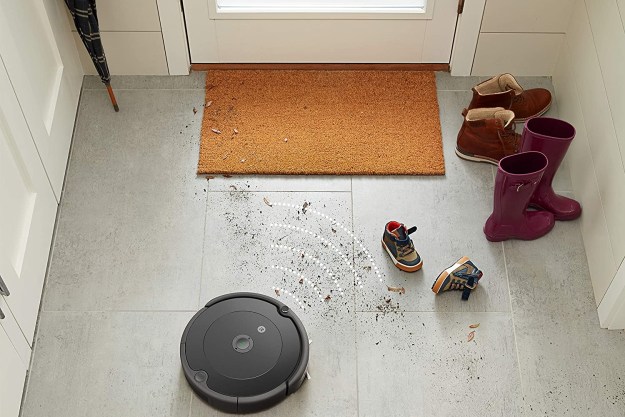Amazon’s Astro home robot undeniably stole the show during the company’s annual fall event, teasing what the future of the home will look like with a friendly bot that can rove around the place. We’ve dreamed of the day when robot butlers would help us tackle some time-consuming chores, like cleaning up the floors, but Astro is being marketed more as a security robot on wheels that can watch over your home — and even check on important matters — while you’re away.
Recently, however, leaked documents indicated that something was amiss with the wheeled home robot. The leaked internal development documents paint Astro as an incomplete, rushed project that’s a “disaster that’s not ready for release.” Furthermore, there’s also a strong chance that it would send itself down a flight of stairs if such a situation presented itself. That’s a scary thing to imagine, especially given that we’re talking about a $1,000 piece of tech here. You don’t want that kind of money flushed down the toilet, or in this case, hurled down the stairs.
While the report doesn’t make a convincing argument for Astro, I actually have full faith that it won’t fall down the stairs — or at the very least, I think it’s almost impossible for that to occur. Why’s that? I only need to look at today’s robot vacuums for the answer.
Common robot vacuum tech in play here
I’ve been testing and reviewing robot vacuums for the last three years, and during that span, I’ve not once had an occurrence of a robot vac falling down stairs. That’s because many of them feature cliff sensors that prevent them from going over edges — stairs being the most obvious culprits. Infrared light beams are emitted by cliff sensors on robot vacuums and bounce off the floor, and they are typically positioned on the underside. Most robot vacuums are equipped with not just one, but several cliff sensors, so the bot can properly survey its route for any pitfalls.

Once reserved for high-end models, cliff sensors have since become ubiquitous — so even many affordable robot vacs now offer them. After having reviewed countless robot vacuums, I have never had a situation where one went down the stairs. I also consulted my circle of friends and colleagues, and no one has ever experienced this either. Zip. Zero. Nada.
The real challenge for today’s robot vacuums is avoiding pesky charging wires that are scattered around floors and outlets, not tumbling down stairs.
Rigorous testing
I reached out to Amazon about the leaked report that alluded to early mentions about Astro’s issues with falling down stairs. Even before getting a response, I really didn’t believe that a device of this caliber would ever be brought to market if it didn’t meet stringent quality assurance measures. Sure, there have been some gadgets that I question how they ever made it to market, but I just can’t imagine how something that’s been in development for four years would have glaring loopholes. Here’s what a spokesperson said:
“These characterizations of Astro’s performance, mast, and safety systems are simply inaccurate. Astro went through rigorous testing on both quality and safety, including tens of thousands of hours of testing with beta participants. This includes comprehensive testing on Astro’s advanced safety system, which is designed to avoid objects, detect stairs, and stop the device where and when necessary.”
Amazon even shared a post on Astro’s Intelligent Motion tech, which details how the home robot achieves its navigational and sensing abilities. I was told that the Astro doesn’t leverage the same exact set of cliff sensors used by today’s robot vacuums — it actually uses a more complex concept that consists of an infra-red time of flight sensor. I’m told that these cliff sensors are located on the front of Astro, above the speaker, which would give it enough of a buffer to detect huge dips.

Naturally, something as complex as Astro is put through intense research and development to ensure safety precautions are in place. That knowledge, combined with the proven tech of cliff sensors in robot vacs, gives me confidence that there isn’t a strong chance of it throwing itself down the stairs.
Anything is possible, but the chances are slim
Established robot vacuum makers like iRobot have proven that they are able to tackle the jungles that are our homes. It’s no easy feat, especially when you’re first to market with something different and unique. Do I believe that the Astro could have experienced problems early on, such as falling down stairs and not functioning in the manner it was intended? Yes. But that’s expected when you’re early in the development cycle — it’s only later on, near completion, when it’s cause for concern.

Even when all the bugs have been ironed out, anything is still possible. Perhaps the sensors are dirtied to the point that they’re not able to function effectively? In that scenario, I can understand if Astro miscalculates something, but this is a problem that affects everything tech. Astro’s introduction was undoubtedly rich with ambitions for a home robot, but I’m optimistic that it follows its robot vacuum ancestors in not teetering over the edge and falling off that perilous first stair.
Editors' Recommendations
- Amazon might be bringing AI smarts to its Astro household robot
- Why Amazon acquiring iRobot will make Roombas even better
- Is a robot vacuum that doesn’t auto-empty even worth it?
- Amazon reveals the science behind Astro, its new home robot
- I’m convinced Amazon Astro will have superior obstacle avoidance. Here’s why




